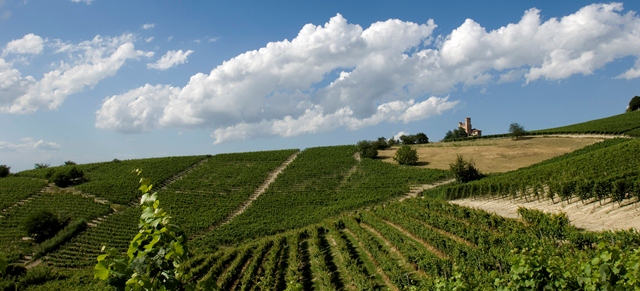The Nebbiolo terroir
The territory where the Nebbiolo variety mainly grows is that included between natural borders marked by the Maritime Alps in the south, the Tanaro river in the west, the Bormida di Spigno river in the east and the Tanaro river and the Monferrato hills of the Asti province in the north. This is the area called Langhe, an area of “tongues of earth or crests”; and this ancient definition reminds its peculiar morphological shape. In fact, a theory talks about narrow hills, in some cases also quite steep, which, from the Liguria region, descended towards north-east along the Tanaro valley. Geologically speaking, the most ancient ones are those in the south: their presence on the geologic time scale is quite recent and can be dated back to 30 million years ago. In the Middle-Upper Eocene, the area today known as Basso Piemonte did not exist because instead of the gentle hills and flatlands there was an ancient seabed where the subsequent sedimentation of rocks, mainly loamy (conglomerates, sandstone, clay), have given origins to the present soil. The first fields of Langhe, in the current Barolo area, formed during the Miocene period, from 15 to 7 million years ago. But it was only in the later Pliocene, under the constant thrust of the African plateau, that these lands started to slowly emerge, while at the beginning of their history, they appeared as large marshy areas. In the Quaternary Era, some 1.5 million years ago, there was a real rise in the soil and the sedimentary lands were deeply affected towards north-west, thus creating the current configuration of the Langhe hills. The soils of the Barolo and Barbaresco areas formed during the Serravallian (or Helvetian) and Tortonian Ages and are mainly composed by sedimentary chalky-clayish marlstones, interlaced with grey-light blue marls (called Sant’Agata marls, or Tov in the local dialect, and composed by 30% sand, 55% clay and 15% limestone) as well as layers of sand or sandstones in a grey-brown and yellowish-brown colour (the so called Sandstones of Diano). The Marls of Sant’Agata, which can be found in the municipalities of La Morra and Barolo, contributes in the production of elegant and perfumed wines, whose aging is also faster. On the contrary, the Diano Sandstones, which can be found in the hills of Castiglione Falletto and partially in those of Monforte, and the Lequio Formation (in part in Monforte and in Serralunga d’Alba) give origins to more alcoholic, strong and long-lived wines. In the Barbaresco area the Marls of Sant’Agata with Tortonian origins prevail. The soils of Langhe, for their high percentage of limestone, are basic ones, with a pH that touches 8%. The soils of the Roero area are different since they are more sandy and less calcareous, thus resulting more acidic. Climate The Langhe area is characterized by a temperate continental climate, with the rainfall peak generally in May, which records, on average, some 100 mm rains, followed by April (80mm) and September (70mm). This water supply can affect the production. In fact, an increased of rainfall levels during the plant blooming can also lead to a significant production decrease, as well as during harvesting, where excessive rainfall can result in moulds and water stagnation that may affect the quality of the grapes. However, the Nebbiolo grape variety is an extremely resistant plant and therefore the few days of rain that normally occur between the end of September and the beginning of October do not affect the quality of the grapes that complete their aging process in those days. Then, if a hot and dry summer follows to a particularly rainy spring, this will add several substances in the grapes. The Langhe are also characterized by a good lightness, which allows the regular development of the photosynthesis. Another dangerous phenomenon for the survival of the bunches is hail, which can affect both quality and quantity, with a significant 20-30% decrease of the produce.
In the Middle-Upper Eocene, the area today known as Basso Piemonte did not exist because instead of the gentle hills and flatlands there was an ancient seabed where the subsequent sedimentation of rocks, mainly loamy (conglomerates, sandstone, clay), have given origins to the present soil. The first fields of Langhe, in the current Barolo area, formed during the Miocene period, from 15 to 7 million years ago. But it was only in the later Pliocene, under the constant thrust of the African plateau, that these lands started to slowly emerge, while at the beginning of their history, they appeared as large marshy areas. In the Quaternary Era, some 1.5 million years ago, there was a real rise in the soil and the sedimentary lands were deeply affected towards north-west, thus creating the current configuration of the Langhe hills. The soils of the Barolo and Barbaresco areas formed during the Serravallian (or Helvetian) and Tortonian Ages and are mainly composed by sedimentary chalky-clayish marlstones, interlaced with grey-light blue marls (called Sant’Agata marls, or Tov in the local dialect, and composed by 30% sand, 55% clay and 15% limestone) as well as layers of sand or sandstones in a grey-brown and yellowish-brown colour (the so called Sandstones of Diano). The Marls of Sant’Agata, which can be found in the municipalities of La Morra and Barolo, contributes in the production of elegant and perfumed wines, whose aging is also faster. On the contrary, the Diano Sandstones, which can be found in the hills of Castiglione Falletto and partially in those of Monforte, and the Lequio Formation (in part in Monforte and in Serralunga d’Alba) give origins to more alcoholic, strong and long-lived wines. In the Barbaresco area the Marls of Sant’Agata with Tortonian origins prevail. The soils of Langhe, for their high percentage of limestone, are basic ones, with a pH that touches 8%. The soils of the Roero area are different since they are more sandy and less calcareous, thus resulting more acidic. Climate The Langhe area is characterized by a temperate continental climate, with the rainfall peak generally in May, which records, on average, some 100 mm rains, followed by April (80mm) and September (70mm). This water supply can affect the production. In fact, an increased of rainfall levels during the plant blooming can also lead to a significant production decrease, as well as during harvesting, where excessive rainfall can result in moulds and water stagnation that may affect the quality of the grapes. However, the Nebbiolo grape variety is an extremely resistant plant and therefore the few days of rain that normally occur between the end of September and the beginning of October do not affect the quality of the grapes that complete their aging process in those days. Then, if a hot and dry summer follows to a particularly rainy spring, this will add several substances in the grapes. The Langhe are also characterized by a good lightness, which allows the regular development of the photosynthesis. Another dangerous phenomenon for the survival of the bunches is hail, which can affect both quality and quantity, with a significant 20-30% decrease of the produce.





